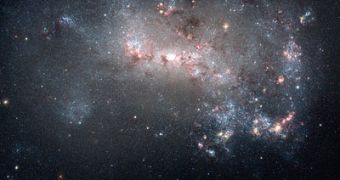The Hubble Space Telescope did it again. It captured a truly amazing picture of what looks like a cosmic display of fireworks, in the dwarf galaxy NGC 4449. A massive starburst shows a wonderful light show in the galaxy and astronomers think it was caused by interaction or merger with a smaller companion.
NGC 4449 is a small irregular galaxy 12 million light-years away, in the small northern constellation of Canes Venatici, (Latin : hunting dogs), one of three constellations that represent dogs, along with Canis Major and Canis Minor.
The NASA/ESA Hubble Space Telescope's Advanced Camera for Surveys took an impressive picture of the dwarf galaxy, in visible light, blue and green, but also in the infrared and hydrogen-alpha regions of the spectrum.
Hundreds of thousands of stars that seem to vibrate in red and blue are present in the picture, with hot white and blue clusters made of numerous massive stars, which spread out throughout the galaxy.
Among them, reddish regions of dust show the locations where most stars are in the process of formation, while massive, dark clouds of dust and gas form an impressionist background.
This galaxy is a stellar nursery for thousands of millions of years, a process which accelerated in the present, producing unusual explosions and intense activity, which qualify as starbursts. These phenomena indicate that the gas feeding the nursery is running out and stars will run out of raw material of which to form, in about a thousand million years.
Starbursts have been seen before by Hubble, usually in the central regions of galaxies, but this is the first ever seen to engulf the entire galaxy and making it the ideal laboratory for the investigation of what may have occurred during galactic formation and evolution in the early Universe.
You can find the Hi-Res version here (37 824 kb). It may take a while to load, so be patient.

 14 DAY TRIAL //
14 DAY TRIAL //